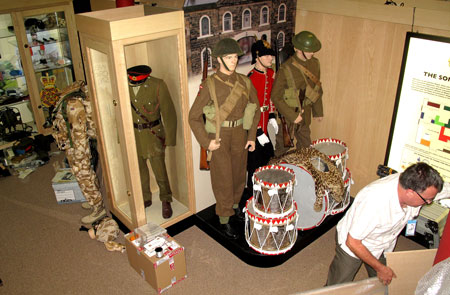
A 4-year, £200,000 project to modernise and upgrade one of the region’s leading regimental museums will be completed next week when the Lancashire Infantry Museum is formally re-opened by international rugby legend, and grandson of a hero of World War I, Bill Beaumont CBE DL.
With interest in Lancashire’s military history at an all-time high because of the centenary of the First World War, work was urgently needed to modernise the 90-year-old museum based at Fulwood Barracks in Preston.
Lieutenant Colonel John Downham, Chairman of the Museum’s Board of Trustees, said: “This Museum represents the historic infantry regiments of Central Lancashire – in particular the East Lancashire, South Lancashire, and Loyal North Lancashire Regiments in which the forebears of so many of today’s Lancashire families fought the two World Wars.”
“We needed to be better able to tell their story, in better settings which more appropriately honour their sacrifices.
“And we were particularly keen that Bill should conduct the re-opening for us as he personally illustrates the eternal link between our regiments and the people of Lancashire.”
Very recent research has revealed that Bill Beaumont’s paternal grandfather, Harry Beaumont, then a Lieutenant in the Loyal North Lancashire Regiment, played a leading role as one of only four officers involved in the defence of the Diyalah River Crossing in Mesopotamia in 1917. The details of this epic battle, in which around 100 trapped Lancashire soldiers held off the Turkish army for some 30 hours, have only become better known in recent years.
Bill will ceremonially re-open the Museum, which has remained open to the public during the refurbishment, in front of an audience of invited guests on Tuesday 2 September.
The work was made possible by generous grants from the Heritage Lottery Fund, the Duchy of Lancaster Benevolent fund, civic grants and fund-raising by many supporters. In particular money raised by Councillor Christine Abram when she was Mayor of Preston sponsored the complete re-fitting of the Waterloo Room, one of the main display rooms.
The project involved:
- the complete redesign and re-fitting of the museum’s principal display area, the Somme Room, using purpose-designed cabinets and interactive digital displays to tell the story of the regiments through the 20th and 21st Centuries;
- The development of the Waterloo Room which relates the history of the regiments in the 19th Century;
- And, the conversion of a former store-room into a much-needed library and educational centre, named the Emsley Room, which has already seen over 2,000 Lancashire school-children pass through since it opened in November last year.
In all the Museum preserves, interprets and displays the artefacts, memorabilia and records of a total of 120 separately-identifiable Regular, Reserve and Volunteer units dating back over 300 years. Through amalgamation and consolidation down the years those units eventually became The Queen’s Lancashire Regiment in 1970, which in turn in 2006 was amalgamated with the Kings Own Royal Border Regiment from Cumbria, and the Kings Regiment from Liverpool and Manchester, to form today’s Duke of Lancaster’s Regiment.







